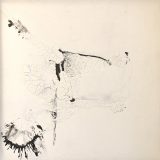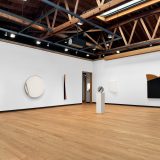An Escalette Halloween Celebrate the spooky season with art!
October 29, 2020
Summer is finally over—even though it’s still too hot—which means it’s time for Halloween. Sure, Halloween is canceled, as far as trick-or-treating and costume parties go, but that doesn’t mean the spirit of Halloween is dead. Halloween is no mere mortal holiday, it is a state of mind. Spooky season is a state of being. Some of you may be saying, “Okay, Jordan, that makes sense. But how do I become Halloween?” To which I say, “Shut up and listen, I’m trying to tell you.” Of course, the best way to become Halloween is to eat a diet of fun-size candy, drink only spider’s milk, break into a different neighbor’s home every night to steal their eggs, and commit yourself to causing one random act of mischief a day. But that’s all Halloween pro stuff, I’m guessing you’re only a beginner. You must prepare your mind before you can prepare your body. To help you get into the mindset, check out some of the spooky artwork found in our very own Escalette Collection.
Eucalyptus Woods and Beehive, by Shai Kremer, is a haunting photo of the “scorched and often barren Israeli landscape,” in the aftermath of the violence committed in its war with its neighboring countries. The landscape is bleak and lonely, eucalyptus trees stretching back into the mist of the forest. Beehives like white boxes dot the ground, alien objects amidst the silence of the trees. Where did everyone go? Who will take care of the bees?
Continuing with our apocalyptic theme, we have Sinister Minister, a painting by Jason Adkins. We have three works of his in our collection, and this piece is the most somber. The landscape is jagged and rough, the sky dreary. The organic forms, almost spider web-like, take over the landscape and serve as a threat to the viewer, as well as a reminder that destruction is imminent and inescapable. Adkins often plays with Biblical themes in his paintings that “connotate epic or apocalyptic ruin.” Sinister minister indeed.

Gary Vann, Yesterday’s Struggle in the Desert, silver gelatin print, 2007. 14 × 11 in. (35.6 × 27.9 cm). Gift of the artist.
Yesterday’s Struggle in the Desert, a photograph by Gary Vann, depicts another barren landscape. This desert is swathed in mist and mystery, jagged cracks and dried up plants parched with drought. Perhaps this is not mist, but smoke and dust, kicked up by whatever struggle occurred here.

Jack Zajac, Ram’s Skull with Broken Horn V, Bronze with brown patina, 1963. 44 × 24 × 34 in. (111.8 × 61 × 86.4 cm). Gift of the Steinmetz Family Collection.
Perhaps it was Ram’s Skull with Broken Horn V that lost the struggle in the desert. Ram’s Skull is one of my favorite sculptures on campus, tucked behind Memorial Hall and next to Doti Hall. The artist is Jack Zajac, known for his Romantic Surrealist sculptures and paintings. The ram is twisted and broken looking, its singular horn curling in on itself. It lies abandoned outside, deformed and alone.
All of these art pieces scream of loneliness. Empty, barren landscapes, the remnants of what once was and what will never be again. I’m sure many of us feel alone right now, and if so, you’re halfway there to channeling Halloween already! This year has been hard, but at least the spirit of Halloween will never be vanquished. Stay safe, wear your mask, eat as much candy as possible, and have a Happy Halloween!
—-
We invite you to explore all the works in the Escalette Collection by visiting our eMuseum.
Wilkinson College of Arts, Humanities, and Social Sciences is the proud home of the Phyllis and Ross Escalette Permanent Collection of Art. The Escalette Collection exists to inspire critical thinking, foster interdisciplinary discovery, and strengthen bonds with the community. Beyond its role in curating art in public spaces, the Escalette is a learning laboratory that offers diverse opportunities for student and engagement and research, and involvement with the wider community. The collection is free and open to the public to view.




